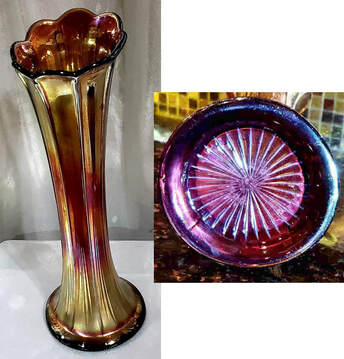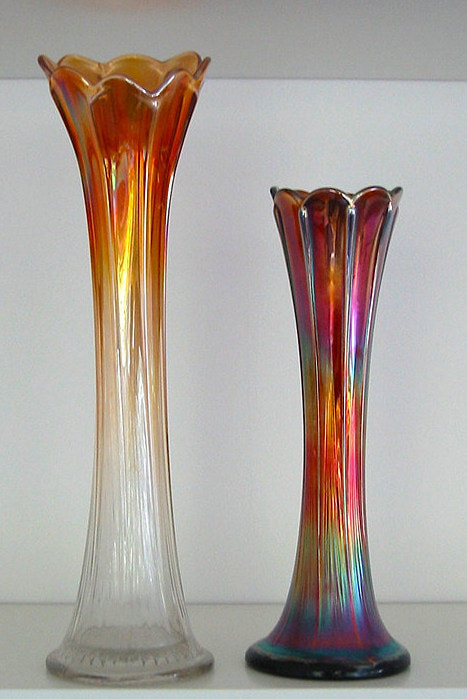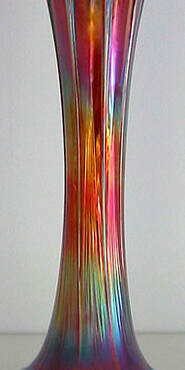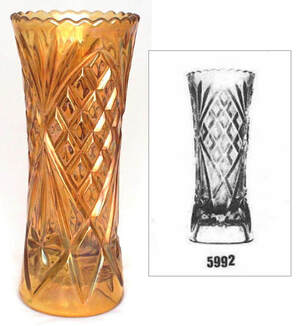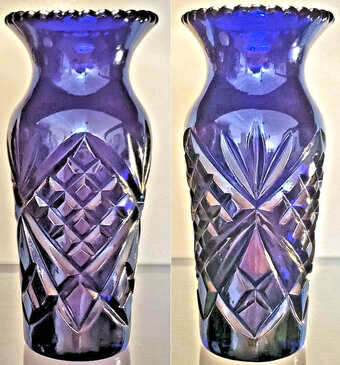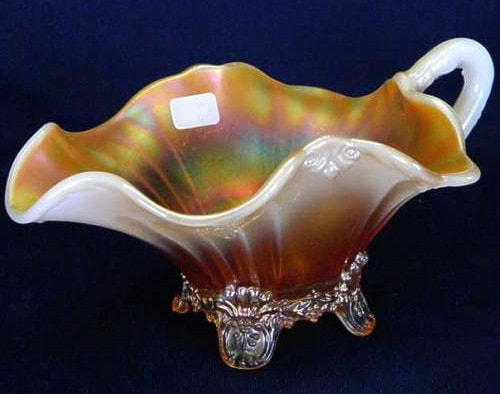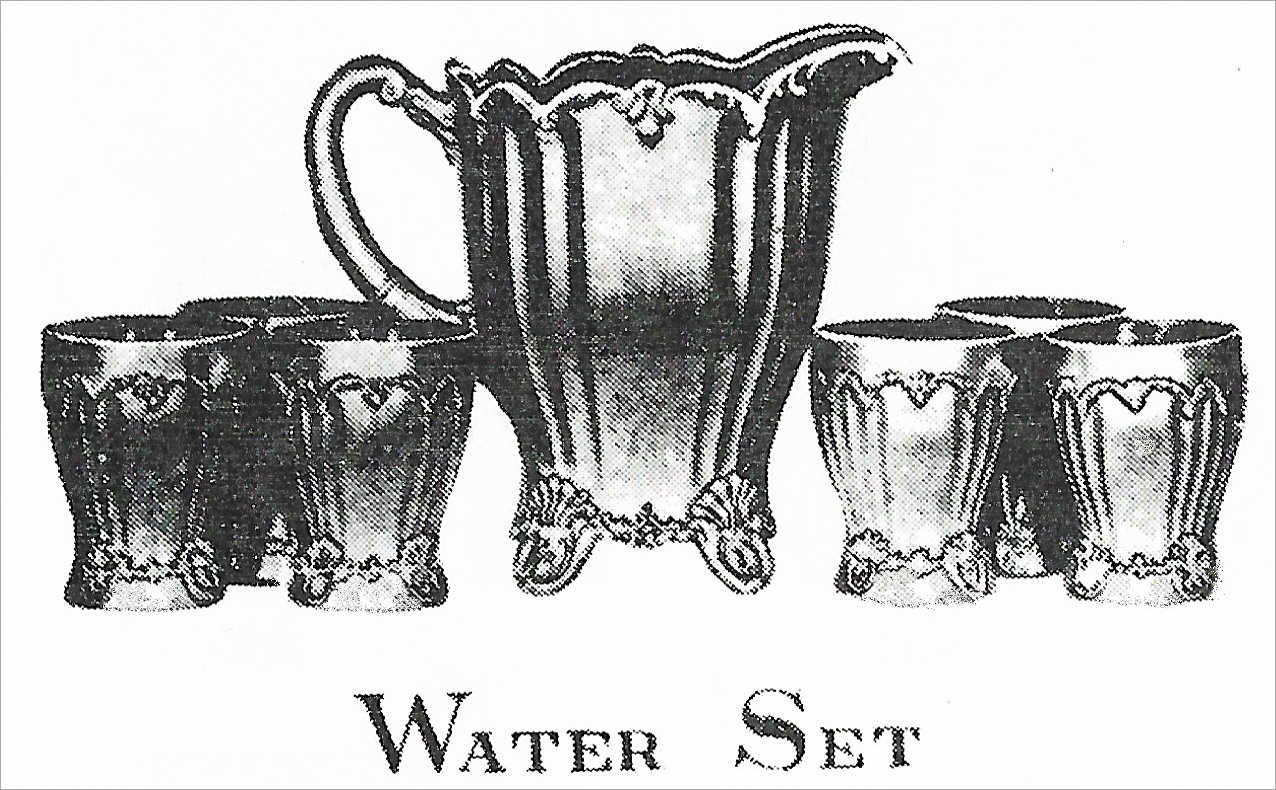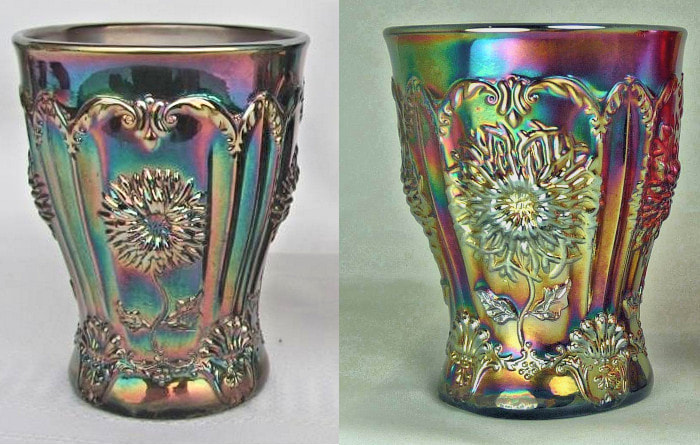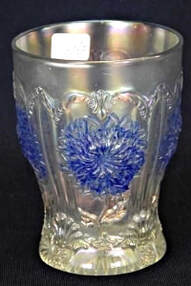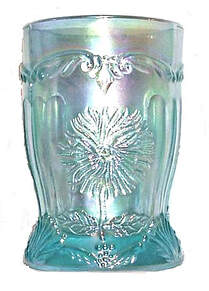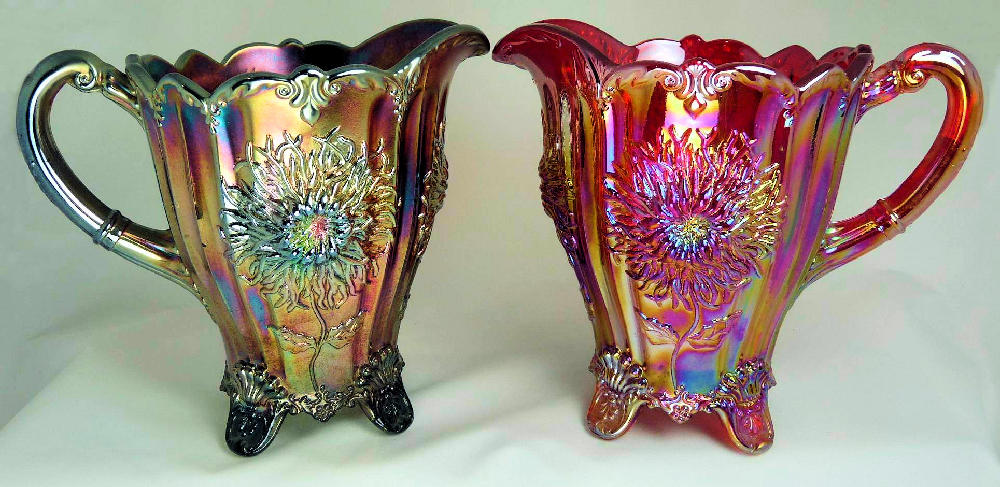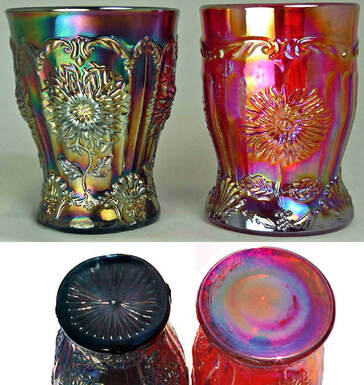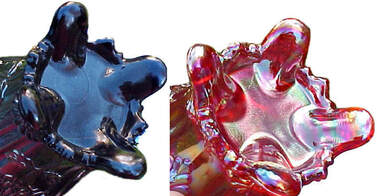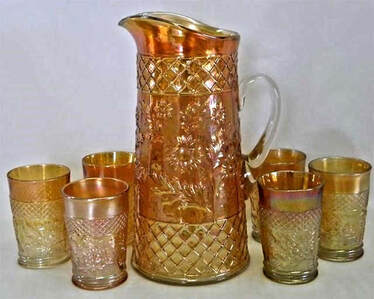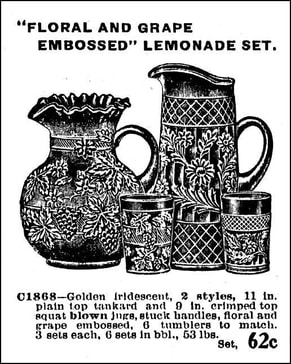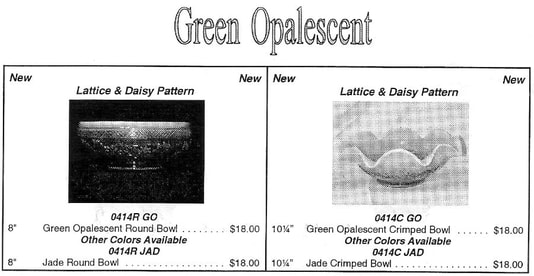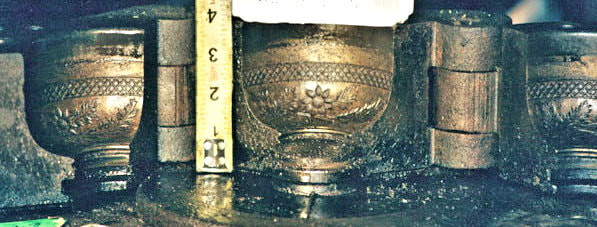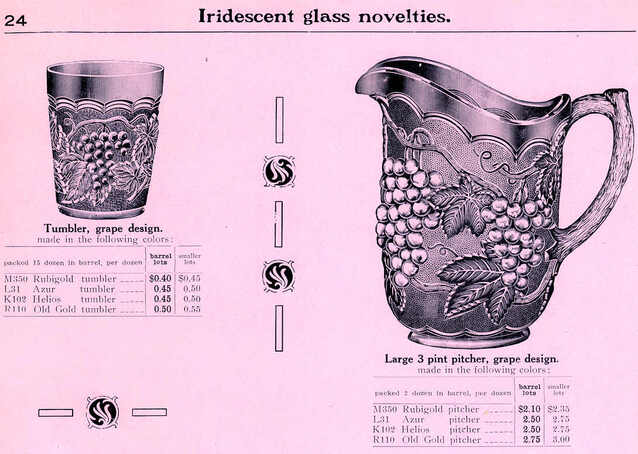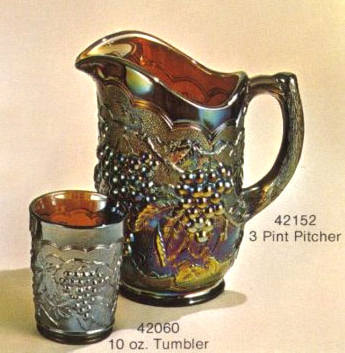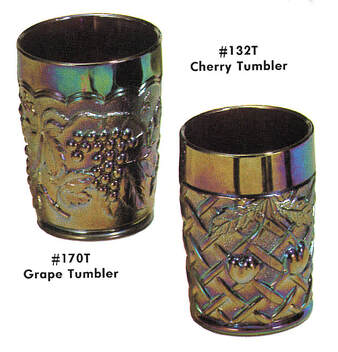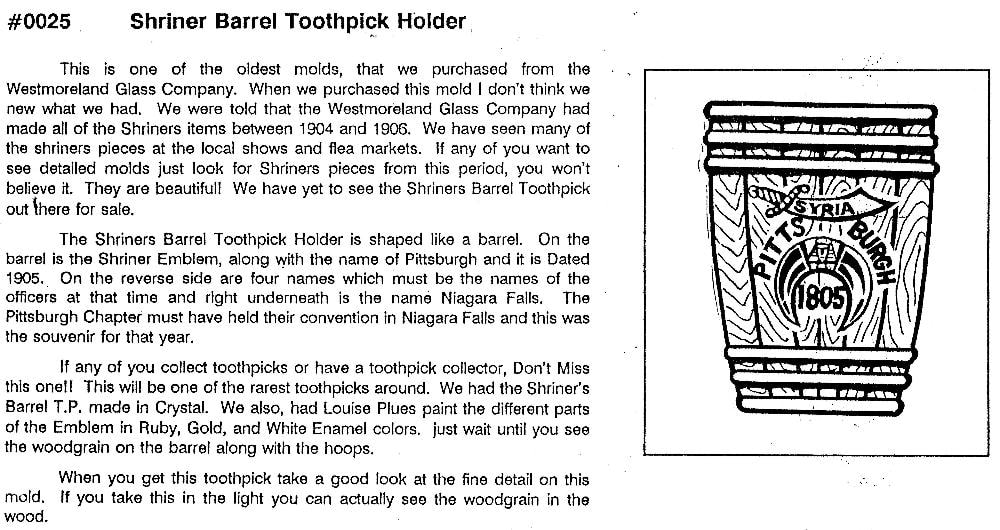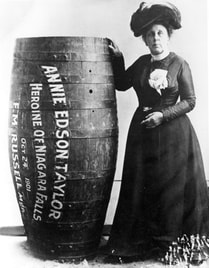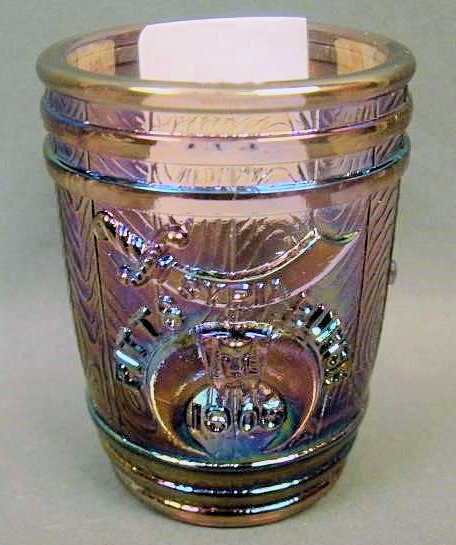NetworK ezine Issue 75. August 2021
Totally Devoted to Carnival Glass
Welcome to the August edition of Carnival Glass NetworK. In this issue we look at some fascinating vases that you may not be familiar with – and we delve further into the topic of Reproductions, with some surprises!
Rib and Flute
Rib and Flute
An unusual vase was recently posted by Debi Bush in our Carnival NetworK Facebook group (see pictures below, courtesy of Debi). Glen identified it as a seldom seen Rib and Flute vase, made by Dugan-Diamond, and Debi kindly agreed we could include here in NetworK.
“Who made this seldom-seen vase? Actually, there were two different moulds for the Rib and Flute vases. One has a 32-point star in the Dugan marie, which means that mould was made by Dugan, although I suspect the marigold examples with iridescence only on the top half or so, were produced by Diamond.
The other mould has a 30-point star on its flat base, which is a Diamond mould. The shade of amethyst seen in these vases is very definitely a Diamond color.” Note that the base of Debi's vase has the 30-point star that Joan describes above.
The other mould has a 30-point star on its flat base, which is a Diamond mould. The shade of amethyst seen in these vases is very definitely a Diamond color.” Note that the base of Debi's vase has the 30-point star that Joan describes above.
|
A Scandinavian Surprise
When Michelle Bezenar showed this pretty blue 6 inch vase (right) in our NetworK Facebook Group it threw us for a loop. It had been named “Hazel” back in the 1990s, maker not known – and in our 2019 Encyclopedia of Carnival from Europe” ebook, we had cautiously suggested the maker might possibly be Hovmantorps of Sweden *. But now here was a blue example – and Hovmantorps were not known for making blue Carnival. So, who made it?
|
Hazel vase, courtesy Michelle Bezenar.
|
The first reported example of “Falling Stars” was by Frances and John Hodgson – these are rare vases and we had felt fortunate indeed to subsequently find one for ourselves. They are 11 inches tall and heavy, and are shown in Riihimaki’s catalogue. The main motifs are identical on both the small blue vase and the taller marigold “Falling Stars” – the pattern variations can be accounted for by the difference in size. We discussed this with the Hodgsons, who agreed with us.
* Note: in our 2019 Encyclopedia entry on “Hazel” we clearly stated that “the maker is not confirmed” and further noted that it was not shown in any catalogue we had studied. We conjectured that the maker was possibly Hovmantorps, but no attribution was given. However, please be aware that some web pages have taken our cautious information (without reference to source or context) and given a firm assertion that Hazel is a definite Hovmantorps item.
* Note: in our 2019 Encyclopedia entry on “Hazel” we clearly stated that “the maker is not confirmed” and further noted that it was not shown in any catalogue we had studied. We conjectured that the maker was possibly Hovmantorps, but no attribution was given. However, please be aware that some web pages have taken our cautious information (without reference to source or context) and given a firm assertion that Hazel is a definite Hovmantorps item.
Reissues, Reproductions and Fakes – further investigation
Dahlia
The original, Classic Carnival Dahlia pattern was made by Dugan. To the best of our knowledge, it doesn’t appear in any of the Butler Bros catalogues, but we see its forerunner here in this extract from Dugan’s 1907 catalogue. The very distinctive shape of the water set is the same as Dahlia – and all the pattern details around the edges and the vertical panels are the same – all that’s missing is that big dahlia flower.
Dahlia
The original, Classic Carnival Dahlia pattern was made by Dugan. To the best of our knowledge, it doesn’t appear in any of the Butler Bros catalogues, but we see its forerunner here in this extract from Dugan’s 1907 catalogue. The very distinctive shape of the water set is the same as Dahlia – and all the pattern details around the edges and the vertical panels are the same – all that’s missing is that big dahlia flower.
|
The water set shown here on the right is known to collectors as Fan, but Dugan referred to it as “Diamond D” Gold Decorated. The Fan pattern isn't known in Carnival in pitcher / tumbler shapes, but other Fan shapes are found in Carnival, such as the sugar (berry bowl or spooner) and the creamer (sometimes called a gravy or sauce boat shape, shown above in peach opal, courtesy of Seeck Auctions).
|
Dugan’s Fan water set, called “Diamond D”, in their 1907 catalogue.
Catalog Reprint of Dugan Glass Co. – Jenning’s Design Company. |
|
A couple of years later some of the Fan moulds were altered to add the impressive and showy flowers specifically to enhance the pattern for iridescent Carnival production and Dugan’s Dahlia was born! It seems Dugan might have tried a smaller dahlia flower first, as a rare variant is known with a much smaller floral motif. And note the clever way the bottom of the Carnival tumblers was made. They appear to have little feet, but it’s an illusion, as you can see clearly in the photos here.
In Classic Carnival, the Dugan originals were made in purple, marigold and white. Sometimes the white versions were gilded or painted, as is the one here on the far right. |
Shown above, on the left is a purple Dahlia Variant tumbler (courtesy Burns Auctions). In the centre
is the regular version with the larger flowers also purple (photo Stephen Thistlewood), and on the right is a white tumbler with gilding and blue decoration (courtesy Seeck Auctions). |
Fast forward to the late 1930s, just under a decade after the devastating fire that had destroyed the Dugan-Diamond glass factory, Si Wright (who established the wholesale glass firm, L.G. Wright) acquired a number of old moulds that came from Dugan-Diamond.
|
A few more decades passed, and in 1975 L.G. Wright commissioned Westmoreland to make Carnival Glass reproductions using some of those old moulds – and one of them was the Dahlia pitcher. But note, only the pitcher. The pitcher appears to be identical to the Classic version, and was almost certainly made from the original mould. A new mould was made for the tumbler, crucially with only three flowers around it, so it is easily distinguished from the Classic original (which has four flowers). Full Dahlia water sets were made by Westmoreland for L.G. Wright, from around 1977 in three Carnival colours - ice blue, white and purple. Terry Crider also custom iridised a few Dahlia tumblers (post production). Extract from Furr’s Gifts catalogue, 1979, of L.G. Wright’s glass. Courtesy Glass Paper Fanatics.
|
An ice blue Dahlia reproduction tumbler, made by Westmoreland for L. G. Wright. Courtesy the late Bob Smith.
|
|
When Wright closed, their moulds were auctioned in 1999. The Dahlia moulds (along with a number of other significant pieces) went to Mosser, and the Dahlia water set went into production again. Some stunning Carnival colours have been made by Mosser in the Dahlia water set, including red, green opal, emerald green, purple, white, amber (or marigold) pink, and light blue or teal. Some of Mosser’s glass is marked with their M mark, or with the state of Ohio shape, but many are not marked at all. The colour will usually be a clue to the maker – but purple, white and marigold were, of course, old Classic colours as well. We also advise that there is often iridescence on the base (underneath) of the reproductions. |
Above: Classic purple Dugan Dahlia pitcher (left) and a red Mosser reproduction pitcher from the 1990s.
|
|
Below: the base of our purple old Classic Dahlia pitcher has no iridescence, while the base of our red 1990s reproduction Dahlia pitcher is covered with iridescence. This feature can often be seen on newer glass, but it should be taken only as a guide, not as a fool-proof method of determining age. Left: Classic purple old Dahlia tumbler on the left – red 1990s reproduction on the right. The new version of the tumbler mould is easily identified by having only three flowers (the original has four); but there are other major differences as well - notably, the new one does not have the same "imitation" stubby feet, as the lower "U" shape is not there. Note also the difference in the maries (bases) - the old version has a many-rayed star and is not iridised, and the reproduction is plain and has iridescence on it. |
Lattice and Daisy
|
Actually, the pattern dated from c. 1915, so strictly speaking, it would have been made by Diamond rather than the earlier Dugan. Scarce old bowls are reported in marigold, but are very seldom seen. Right: a 1915 Butler Brothers catalogue extract showing Lattice and Daisy water set alongside Dugan-Diamond’s Floral and Grape set. |
Left: Classic Lattice and Daisy marigold water set, courtesy Seeck Auctions. This was a Dugan-Diamond pattern known mainly in water sets in (mostly) marigold and occasionally blue and amethyst. |
Many collectors are unaware, however, that Lattice and Daisy has been reproduced in the large bowl and chop plate shapes. These reproductions have confused many, including experienced and knowledgeable people.
The Rosso ad above, left, is from November 2000 – the pieces shown are reproductions of (Dugan) Diamond’s Lattice and Daisy. The colours noted in the ad are jade and green opalescent, which are not iridised, but we have also seen these bowls in Carnival - in red, vaseline and deep orange / marigold - in unruffled form as well as round and cupped-in shapes. A 12 inch chop plate is also known in red; the pattern is all exterior, the inside is plain, and it has a many rayed star on the marie/collar base.
We believe they were made by Mosser for Rosso. It seems possible that they were made using the old mould. Interestingly, the Lattice and Daisy small berry bowl mould was listed in the records at Fenton, and identified as the Dugan-Diamond mould purchased by Fenton in the L.G. Wright mould sale. There is, as yet, no evidence that Fenton actually put this mould into production - or indeed that they had any of the other Lattice and Daisy moulds.
We believe they were made by Mosser for Rosso. It seems possible that they were made using the old mould. Interestingly, the Lattice and Daisy small berry bowl mould was listed in the records at Fenton, and identified as the Dugan-Diamond mould purchased by Fenton in the L.G. Wright mould sale. There is, as yet, no evidence that Fenton actually put this mould into production - or indeed that they had any of the other Lattice and Daisy moulds.
Imperial Grape
Above: Imperial catalogue extract from 1912 showing Imperial Grape tumbler and pitcher. Courtesy Jon D Bartell.
Imperial’s popular “Imperial Grape” pattern was made in a wide range of Classic Carnival shapes and colours, from around 1912.
Marigold, purple, helios and amber were the main Carnival colours produced.
Imperial’s popular “Imperial Grape” pattern was made in a wide range of Classic Carnival shapes and colours, from around 1912.
Marigold, purple, helios and amber were the main Carnival colours produced.
|
The Imperial Grape water set was reissued by Imperial in the 1960s and 70s, in the standard 10 oz tumbler in marigold (rubigold), smoke (peacock), green, white and amber, as shown here, above, in a 1973 catalogue.
The marigold and smoke ones were also made in a taller 12oz ice tea size. They were all marked IG. |
But we were surprised recently when we came across the catalogue extract that shows Mosser also made an Imperial Grape tumbler in purple Carnival. Here it is in their catalogue in 1982. We don’t know if they had a Mosser mark, or were issued unmarked. Quite a surprise! The other tumbler is Mosser's Cherry and Lattice which was not made in Classic Carnival.
|
|
Shriner Barrel Toothpick Holder
In the last issue of NetworK, we asked if you could make a connection between the image (right), and Carnival Glass. The picture shows 63 year old Annie Taylor, who in 1901 was the first person to do so and survive. She told the press afterwards: “If it was with my dying breath, I would caution anyone against attempting the feat ... I would sooner walk up to the mouth of a cannon, knowing it was going to blow me to pieces than make another trip over the Fall.” The connection is Shriner Barrel Toothpick Holder, just 2 inches high. The originals were not iridised; they were made by Westmoreland in 1905 in two colours – cobalt blue and amethyst, with the details hand-painted in gold. The barrel shape played to the “craze” at that time, for going over Niagara Falls in a barrel. However, a Carnival version of the toothpick holder was reproduced in the 1990s. Above is the Rosso catalogue description of the reproduction toothpick.
Note that the drawing of the item incorrectly shows the date on the front to be 1805, when in fact on the actual item, and in the description, it was correctly shown as 1905. We have seen these Carnival reproductions in amethyst and in vaseline, as well as several other colours. Some of them were hand-painted too, as described in the Rosso ad above. |
A reproduction Shriner Barrel Toothpick Holder. Courtesy Burns Auctions.
|
The original toothpick holders were not made in Carnival, and when the reproductions first appeared, it fooled a lot of people ... and it still does to some extent. As recently as 2019, an amethyst one (like the one shown above, albeit called "lavender"), was sold as a shot glass in a specialist Carnival Glass tumbler auction. In fact, you can easily find them for a few dollars on popular online sales sites.
If you have missed any of the previous issues of NetworK and NetworK Specials, they are all here: Back Issues.
Privacy and the use of your information: we only use your name and email address to send you your FREE Carnival Glass NetworK ezine. We will not share your name or email address with anyone else, or use it for any other purpose. You can change your mind about receiving your NetworK ezine at any time by clicking the unsubscribe link at the foot of every issue, or by emailing us at [email protected]
Join us on Facebook
We would love you to come and join in the fun, and we invite you and your friends to join us all on NetworK's fast growing and very active Facebook Group!
We would love you to come and join in the fun, and we invite you and your friends to join us all on NetworK's fast growing and very active Facebook Group!

